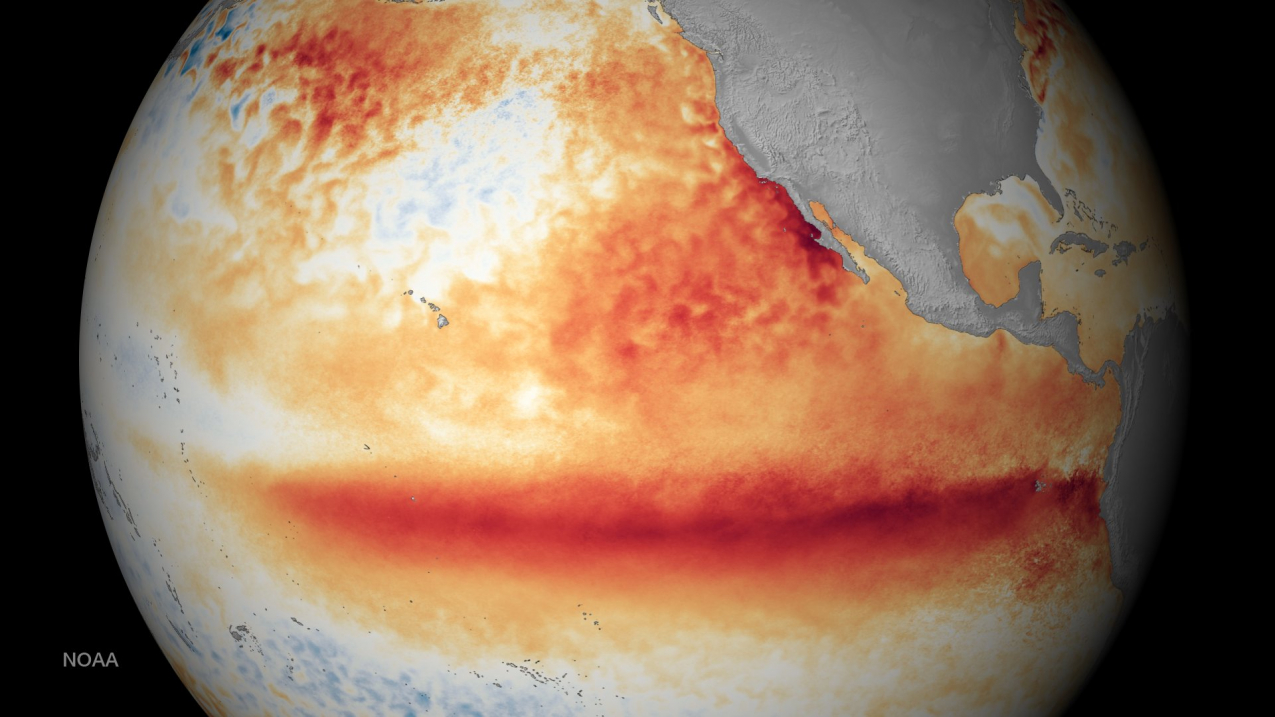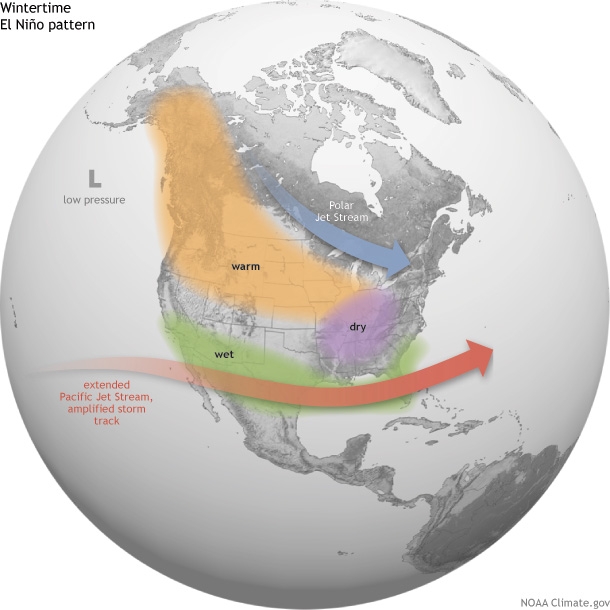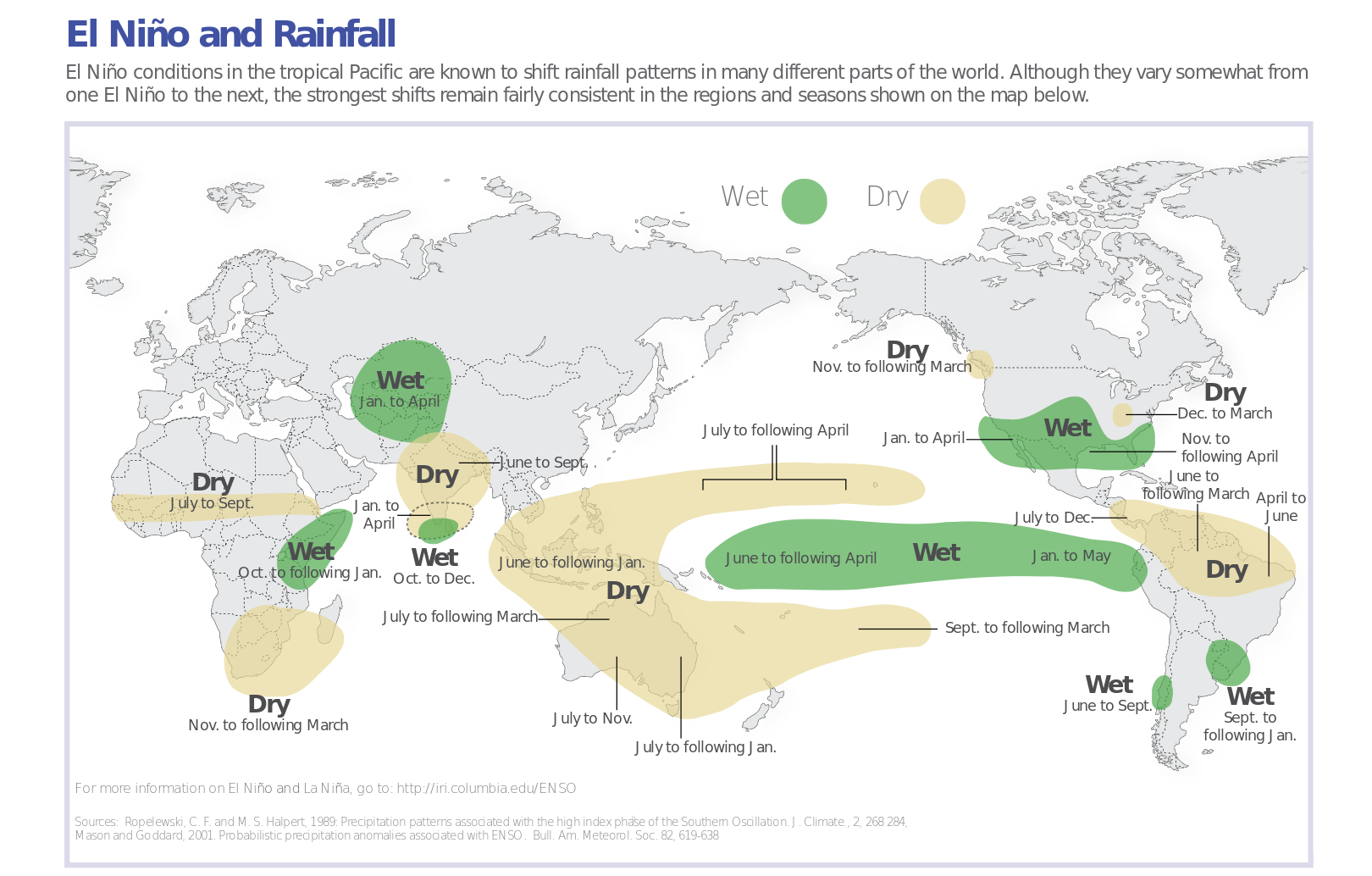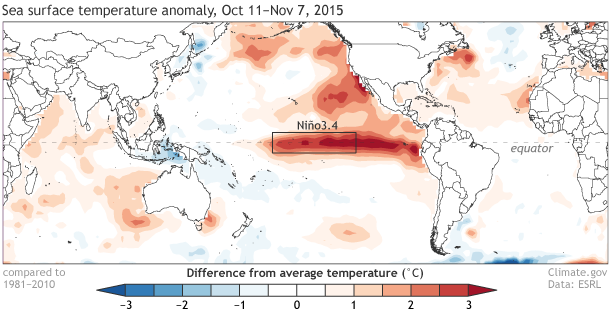
Satellite sea surface temperature departure in the Pacific Ocean for the month of October 2015, where darker orange-red colors are above normal temperatures and are indicative of El Niño. (Image credit: NOAA)
Understanding El Niño
What is El Niño?
Impacts of El Niño
Forecasting climate patterns
Understanding what drives El Niño
El Niño is a naturally occurring climate pattern associated with warming of the ocean surface temperatures in the central and eastern tropical Pacific Ocean, which can significantly influence weather patterns, ocean conditions, and marine fisheries worldwide.
El Niño occurs on average every two to seven years, and episodes typically last nine to 12 months. El Nino has its largest impacts during the winter. In the winter, El Niño typically brings milder weather to the northern parts of the United States and wetter conditions across the southern United States. The opposite of El Niño is La Niña, the cold phase, which also changes weather worldwide. There is also a neutral stage with neither unusually warm nor cool water in the equatorial Pacific. All three stages together are referred to as ENSO or the El Niño-Southern Oscillation.
In the U.S., NOAA declares when an El Niño or La Niña event has begun. For El Niño conditions to form, monthly sea surface temperatures in the central and eastern tropical Pacific Ocean (Nino 3.4 region) need to warm +0.5° Celsius above normal, with the expectation that the warming will persist for five consecutive overlapping three month periods. In addition, the atmosphere must respond to the warming water by weakening the prevailing winds, known as the trade-winds and also shift patterns of tropical rainfall eastward. This ocean–atmosphere coupling impacts the position of the Pacific jet stream and influences weather and climate patterns globally.

Climate records of El Niño go back millions of years, with evidence of the cycle found in ice cores, deep sea muds, coral, caves and tree rings. El Niño means the Little Boy, or Christ Child in Spanish and was first noticed in the 1600’s by Spanish fishermen off the coast of South America near Peru and Ecuador. It was so named because it typically occurred around Christmas.
While El Niño's impacts are most strongly felt in the tropics, its effects can disrupt local weather patterns around the world, having positive and negative consequences.
As the trade winds weaken and the warm tropical Pacific Ocean water sloshes to the east, increased heat and moisture rises into the atmosphere in the central and eastern Tropical Pacific Ocean, altering weather patterns in neighboring regions and around the globe.

A strong El Niño will shift the Pacific jet stream, which helps determine temperature and precipitation patterns over the United States and alters the track of winter storms -- leading to more winter storms over California and the southern United States. Record rainfall often strikes Peru, Chile and Ecuador during an El Niño year. In contrast, El Niño can also cause severe droughts over Australia, Indonesia, and parts of southern Asia.
During the summer, El Niño’s warm water can fuel hurricanes in the central/eastern Pacific Ocean, while it hinders the hurricane formation in the Atlantic Basin. In the winter, when El Niño impacts are felt strongest, it typically brings wetter and cooler than normal conditions across the southern part of the United States from central California to Florida and up the East Coast while warmer and drier than average conditions are typical for the Northern Tier of the U.S. to the Great Lakes. The strength – weak, moderate, strong - of an individual El Niño influences the odds of these outcomes.
Warmer ocean temperatures and altered currents during El Niño cause changes in the distribution and abundance of fish and other species off the coast of northern South America; marine life migrates north and south, following colder water. During strong El Niños, these changes can be seen as far north as the Gulf of Alaska.
NOAA researchers and scientists have made tremendous advances since the 1980’s, when forecasting of El Niño began.
Forecasters at NOAA’s Climate Prediction Center (CPC), the nation’s official source for monitoring and forecasting the El Niño-Southern Oscillation (ENSO), rely on a variety of observations from satellites, moored buoys, drifting buoys, sea level analysis, and ships. The data is fed as a source of input into computer models and used for guidance to make a forecast. A team of eleven forecasters issue a consensus forecast on the second Thursday of each month.
It is difficult to predict the onset of an El Niño, because there is not one trigger but a series of reactions to the warming pacific ocean. Though, once an El Niño has started, forecasters have reasonably good skill in predicting its intensity and evolution.

One of the most important datasets forecasters use when deciding whether to declare that El Niño has arrived, or it has gone, is the temperature of the sea surface in the equatorial Pacific Ocean. Forecasters also closely monitor whether the atmosphere is responding to the warming ocean causing tropical trade winds to weaken or reverse and blow west to east toward South America. This coupling of the ocean and atmosphere is necessary for El Niño to exist.
NOAA forecasters categorize El Niños as weak, moderate, or strong. Not all El Niños are the same, nor do the atmosphere and ocean always follow the same patterns from one El Niño to another.
NOAA’s ENSO Blog features article from experts monitoring and forecasting El Niño, La Niña, and their impacts--particularly the strong event of 2015.
For more than four decades, NOAA researchers have probed the processes that drive El Niño-Southern Oscillation (ENSO) in order to better predict the global weather phenomenon and its effects on everything from weather to agriculture to fisheries. NOAA scientists have been international leaders in developing technology to detect changes in the Pacific Basin in real time that form the foundation of predicting El Niño.
In the early 1980s, NOAA scientists understood that a key to detecting the onset of El Niño was real-time data on ocean temperatures in the Pacific Basin. This led to the development of the Tropical Atmosphere Ocean Array, a system of moored buoys that measures ocean temperature and other weather data and transmits this information in real time via satellite for use by forecasters, research scientists, water managers, and those working in agriculture, fisheries, public health, risk management and ecological resource management.
NOAA was motivated to build the TAO Array by the 1982-1983 El Niño event which was the strongest one at that point. In 10 years, a system of 70 moorings were placed in the ocean.
Real-time data from moored ocean buoys improves detection, understanding and prediction of El Niño and La Niña. (NOAA)
Today NOAA and the Japan Agency for Marine-Earth Science Technology are leading an effort involving scientist from many other nations to improve this early warning system. The Tropical Pacific Observing System 2020 offsite link is a plan to integrate new technology to observe and monitor ENSO events. It will use not just anchored moorings, but floats, satellites and new technology to deliver the best information.
NOAA researchers also study the larger processes that drive El Niño impacts globally. These activities provide environmental information to assist with real world problems such as better ways to anticipate drought, increased wildfires, flooding and threats to food security. They analyze historical patterns to develop ways to distinguish different types of El Niño events and their signature effects. NOAA climate modelers are engaged in vigorous efforts to understand and simulate ENSO, to forecast its effects on seasonal-to-interannual time scales, and to predict how its impacts may change over the coming decades.
El Niño is a naturally occurring climate pattern associated with warming of the ocean surface temperatures in the central and eastern tropical Pacific Ocean, which can significantly influence weather patterns, ocean conditions, and marine fisheries worldwide.
El Niño occurs on average every two to seven years, and episodes typically last nine to 12 months. El Nino has its largest impacts during the winter. In the winter, El Niño typically brings milder weather to the northern parts of the United States and wetter conditions across the southern United States. The opposite of El Niño is La Niña, the cold phase, which also changes weather worldwide. There is also a neutral stage with neither unusually warm nor cool water in the equatorial Pacific. All three stages together are referred to as ENSO or the El Niño-Southern Oscillation.
In the U.S., NOAA declares when an El Niño or La Niña event has begun. For El Niño conditions to form, monthly sea surface temperatures in the central and eastern tropical Pacific Ocean (Nino 3.4 region) need to warm +0.5° Celsius above normal, with the expectation that the warming will persist for five consecutive overlapping three month periods. In addition, the atmosphere must respond to the warming water by weakening the prevailing winds, known as the trade-winds and also shift patterns of tropical rainfall eastward. This ocean–atmosphere coupling impacts the position of the Pacific jet stream and influences weather and climate patterns globally.

Climate records of El Niño go back millions of years, with evidence of the cycle found in ice cores, deep sea muds, coral, caves and tree rings. El Niño means the Little Boy, or Christ Child in Spanish and was first noticed in the 1600’s by Spanish fishermen off the coast of South America near Peru and Ecuador. It was so named because it typically occurred around Christmas.
While El Niño's impacts are most strongly felt in the tropics, its effects can disrupt local weather patterns around the world, having positive and negative consequences.
As the trade winds weaken and the warm tropical Pacific Ocean water sloshes to the east, increased heat and moisture rises into the atmosphere in the central and eastern Tropical Pacific Ocean, altering weather patterns in neighboring regions and around the globe.

A strong El Niño will shift the Pacific jet stream, which helps determine temperature and precipitation patterns over the United States and alters the track of winter storms -- leading to more winter storms over California and the southern United States. Record rainfall often strikes Peru, Chile and Ecuador during an El Niño year. In contrast, El Niño can also cause severe droughts over Australia, Indonesia, and parts of southern Asia.
During the summer, El Niño’s warm water can fuel hurricanes in the central/eastern Pacific Ocean, while it hinders the hurricane formation in the Atlantic Basin. In the winter, when El Niño impacts are felt strongest, it typically brings wetter and cooler than normal conditions across the southern part of the United States from central California to Florida and up the East Coast while warmer and drier than average conditions are typical for the Northern Tier of the U.S. to the Great Lakes. The strength – weak, moderate, strong - of an individual El Niño influences the odds of these outcomes.
Warmer ocean temperatures and altered currents during El Niño cause changes in the distribution and abundance of fish and other species off the coast of northern South America; marine life migrates north and south, following colder water. During strong El Niños, these changes can be seen as far north as the Gulf of Alaska.
NOAA researchers and scientists have made tremendous advances since the 1980’s, when forecasting of El Niño began.
Forecasters at NOAA’s Climate Prediction Center (CPC), the nation’s official source for monitoring and forecasting the El Niño-Southern Oscillation (ENSO), rely on a variety of observations from satellites, moored buoys, drifting buoys, sea level analysis, and ships. The data is fed as a source of input into computer models and used for guidance to make a forecast. A team of eleven forecasters issue a consensus forecast on the second Thursday of each month.
It is difficult to predict the onset of an El Niño, because there is not one trigger but a series of reactions to the warming pacific ocean. Though, once an El Niño has started, forecasters have reasonably good skill in predicting its intensity and evolution.

One of the most important datasets forecasters use when deciding whether to declare that El Niño has arrived, or it has gone, is the temperature of the sea surface in the equatorial Pacific Ocean. Forecasters also closely monitor whether the atmosphere is responding to the warming ocean causing tropical trade winds to weaken or reverse and blow west to east toward South America. This coupling of the ocean and atmosphere is necessary for El Niño to exist.
NOAA forecasters categorize El Niños as weak, moderate, or strong. Not all El Niños are the same, nor do the atmosphere and ocean always follow the same patterns from one El Niño to another.
NOAA’s ENSO Blog features article from experts monitoring and forecasting El Niño, La Niña, and their impacts--particularly the strong event of 2015.
For more than four decades, NOAA researchers have probed the processes that drive El Niño-Southern Oscillation (ENSO) in order to better predict the global weather phenomenon and its effects on everything from weather to agriculture to fisheries. NOAA scientists have been international leaders in developing technology to detect changes in the Pacific Basin in real time that form the foundation of predicting El Niño.
In the early 1980s, NOAA scientists understood that a key to detecting the onset of El Niño was real-time data on ocean temperatures in the Pacific Basin. This led to the development of the Tropical Atmosphere Ocean Array, a system of moored buoys that measures ocean temperature and other weather data and transmits this information in real time via satellite for use by forecasters, research scientists, water managers, and those working in agriculture, fisheries, public health, risk management and ecological resource management.
NOAA was motivated to build the TAO Array by the 1982-1983 El Niño event which was the strongest one at that point. In 10 years, a system of 70 moorings were placed in the ocean.
Real-time data from moored ocean buoys improves detection, understanding and prediction of El Niño and La Niña. (NOAA)
Today NOAA and the Japan Agency for Marine-Earth Science Technology are leading an effort involving scientist from many other nations to improve this early warning system. The Tropical Pacific Observing System 2020 offsite link is a plan to integrate new technology to observe and monitor ENSO events. It will use not just anchored moorings, but floats, satellites and new technology to deliver the best information.
NOAA researchers also study the larger processes that drive El Niño impacts globally. These activities provide environmental information to assist with real world problems such as better ways to anticipate drought, increased wildfires, flooding and threats to food security. They analyze historical patterns to develop ways to distinguish different types of El Niño events and their signature effects. NOAA climate modelers are engaged in vigorous efforts to understand and simulate ENSO, to forecast its effects on seasonal-to-interannual time scales, and to predict how its impacts may change over the coming decades.

